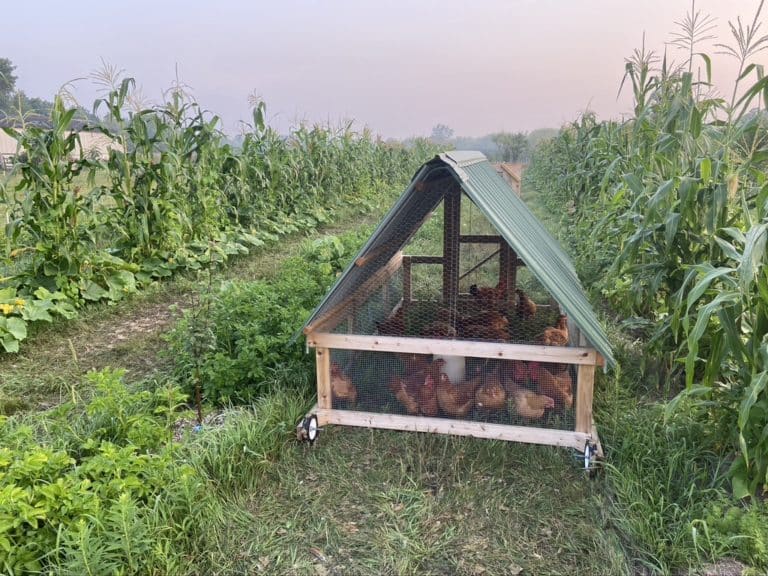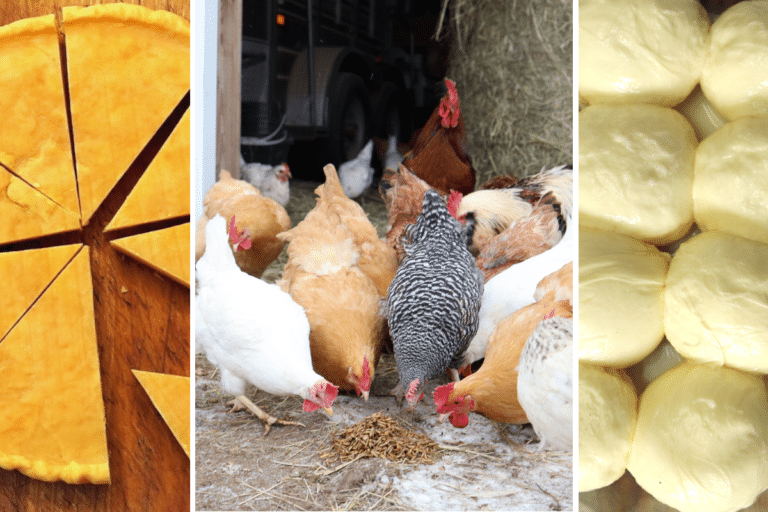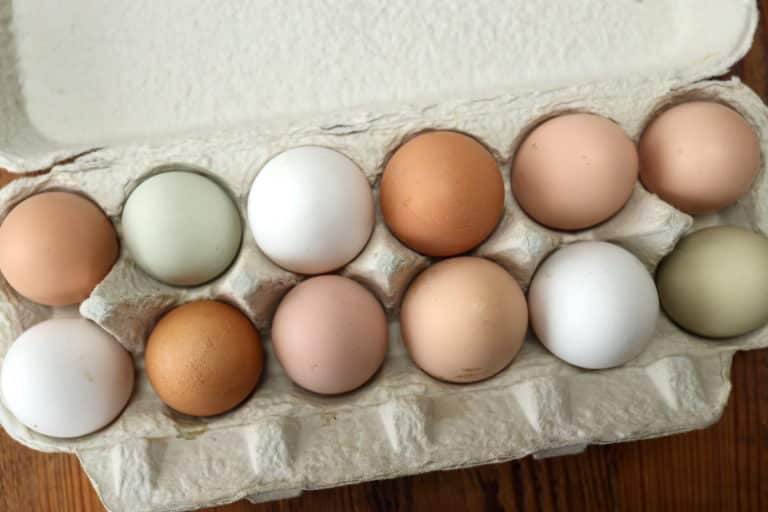How To Care For Chickens In The Winter (Beginner’s Guide!)
You have backyard chickens or are thinking about getting them but there’s one BIG question—How to care for chickens in the winter? Don’t fret! It’s much more simple than you may think. We’ll share our top tips for keeping your chickens safe and healthy during those frosty, snowy months.

From Our Suburban Backyard to Our Homestead
We’ve kept chickens for over 10 years now. It began with 6 backyard chickens on our 1/3 acre suburban lot. And now some 50 feathery friends free range about our 5-acre homestead property.
We’ve also had a variety of coop setups.
Our first coop was a kit coop from Costco that we received as a gift. When we wanted to expand our suburban flock, we converted a wooden kid’s playset into an A-frame portable chicken tractor.
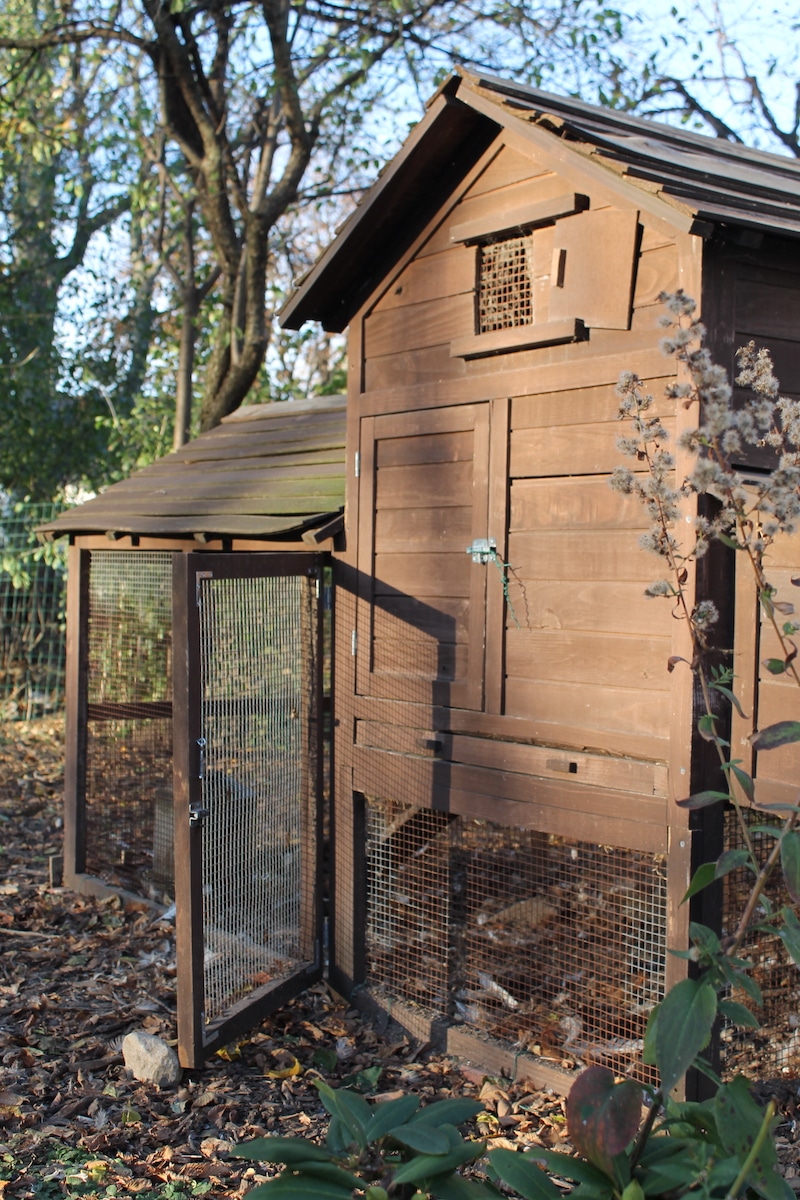
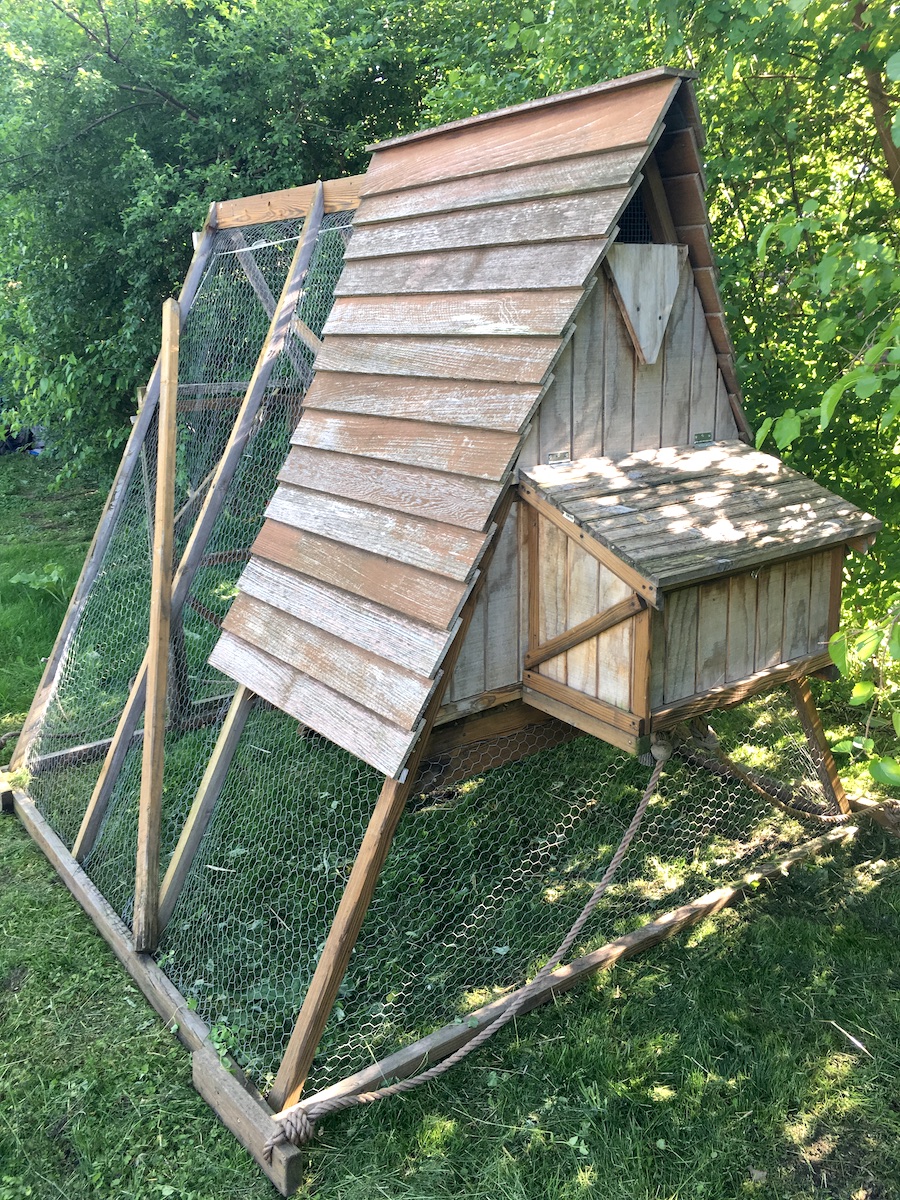
Instead of having a standalone coop currently at our homestead, we decided to build a coop inside our pole barn, which has worked out great!
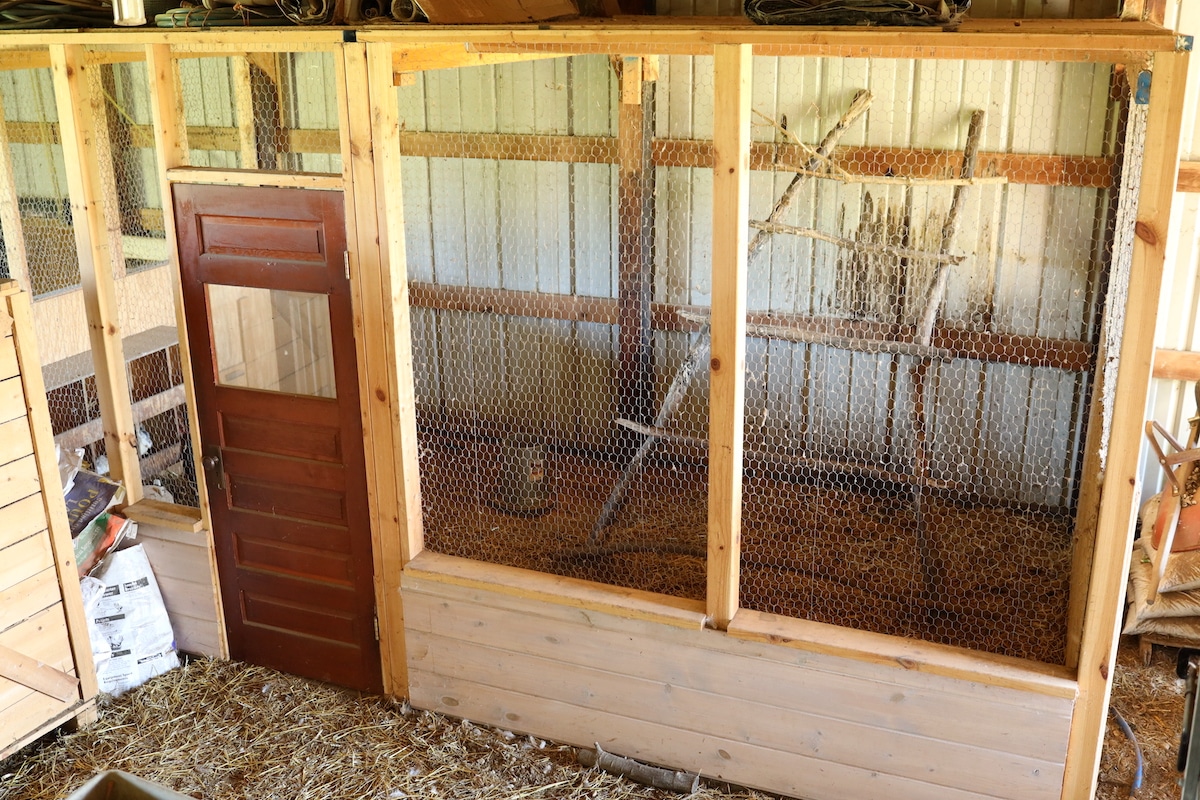
In all these scenarios living in northern Illinois (we get some cold winters!) we’ve never lost a chicken due to winter conditions. That’s not because we never made mistakes or always knew exactly what we were doing. We’ve learned a lot as we went!
But we went for it, troubleshooted as needed, made adjustments, and tried to be more prepared the following year.
You CAN raise chickens in the wintertime too! Here’s what you need to know.
How To Care For Chickens In The Winter – Top 5 Tips!
Chickens are hardy birds that are built for cold climates. Their full, feathery coats and higher-than-average body temps make them well-suited to brave the cold. But there are some basic steps on your part as a chicken keeper to help them thrive in cold weather.
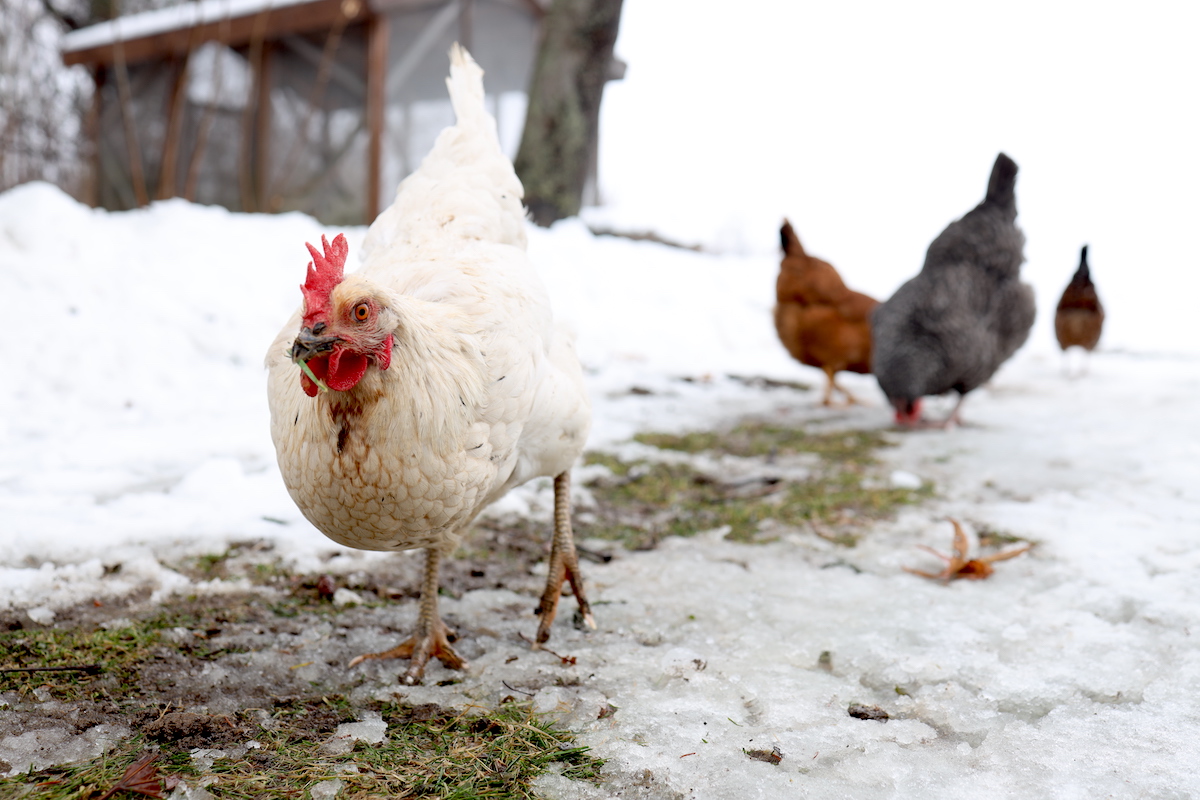
1. Minimize Drafts In The Coop & Run
Exposure to frigid winds is one of the greatest threats to your chickens in the winter. We’ve all experienced the “feels like” temperatures that drop well below the actual temperatures due to wind chill. Creating a windbreak, or even insulating your chicken’s coop and run is a must.
The enclosed area of a coop is often sealed up from cold air pretty well. It’s a good idea to close up any vents on the coop. But you don’t want the enclosed area sealed off completely to maintain good ventilation. Without adequate ventilation, excess moisture can build up quickly, which can lead to frostbite.
However, a chicken coop run—the area on the ground where chickens roam—is usually open and exposed to the elements. The most important thing is sealing off the run on at least 3 sides for a complete wind break. Here are a couple options to winter-proof your run:
1. Plastic Sheeting or Tarps – Stapling thick plastic sheeting around the walls of your run is a quick and easy way to seal it off. We always used a 4-mil or 6-mil clear plastic sheeting that you can find at a hardware store. Or thick tarps will work as well.
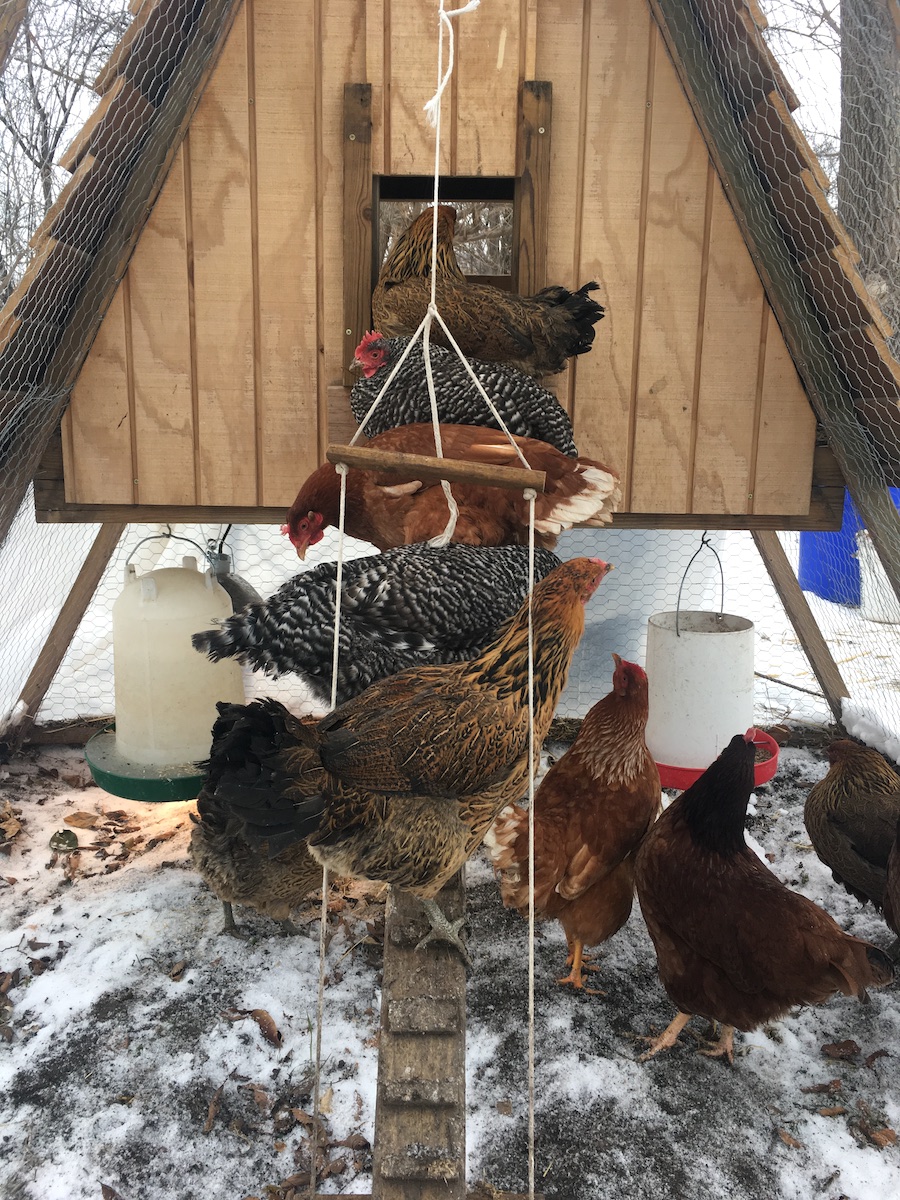
2. Plywood or Metal Roofing – Not only will screwing on these panels to the wall or your run keep snow and wind out, but it can also provide an extra layer of security when predator pressures are up.
3. Straw Bales – Bales of straw (or hay) stacked tightly around your chicken coop or run not only make an excellent windbreak but also act as a layer of insulation.
2. Keep A Dry Coop
When temps dip below freezing, a dry hen is much less susceptible to frostbite, disease, and any other wintertime woes that can pop up. Two options exist.
Option one, you can clean your coop regularly. This is best suited for smaller coops that can’t handle a lot of buildup of bedding and manure. With the kit coop we had that fit 6 chickens, I was able to add a few layers of fresh bedding like wood shavings, mulch, or straw to keep things fresh and dry. But at least once a month the moisture buildup got too intense for the small space and I needed to go in there and do a full clean out and start new.
Option two is what’s called the Deep Litter Method. This bedding method is where you continually add fresh layers of carbon on top of manure and leave the layers in place. Carbon can be straw, wood chips, wood shavings, or even leaves and grass clippings that will absorb moisture and give your birds a clean, dry bedding under their feet.

The key to this method is consistently applying enough carbon. When applied at the right ratio, fresh bedding will eliminate any odor from chicken poop. Another significant benefit is that the lower layers will eventually begin composting, which acts as a heat source in your coop.
The Deep Litter Method is best suited for larger coops, runs, or chicken tractors that can handle a buildup of many bedding layers throughout the winter. We’ve had a lot of success applying this method to both our A-frame chicken tractor and barn coop over the years.
As a bonus, the manure/bedding mixture can be added to the compost pile in the springtime, eventually breaking down into rich compost for your garden!
3. Keep Water From Freezing
Chickens always need access to clean, fresh water. This can be a major challenge in the winter. There are three common ways to prevent water from freezing.
1. Heated Waterer Base – Purchasing a heated waterer base and putting your existing waterer on top is a fast and convenient way to get up and going. Just note that most manufacturers of these bases only guarantee they will work if you also purchase their double-wall insulated metal waterer to accompany it, which can get expensive.
For a lower-cost alternative, I came up with this DIY Heated Chicken Waterer Base a few years back. It’s worked perfectly for us, parts can easily be replaced, and you can pair it with your existing waterer! Our post gives a full step-by-step guide to build your own.
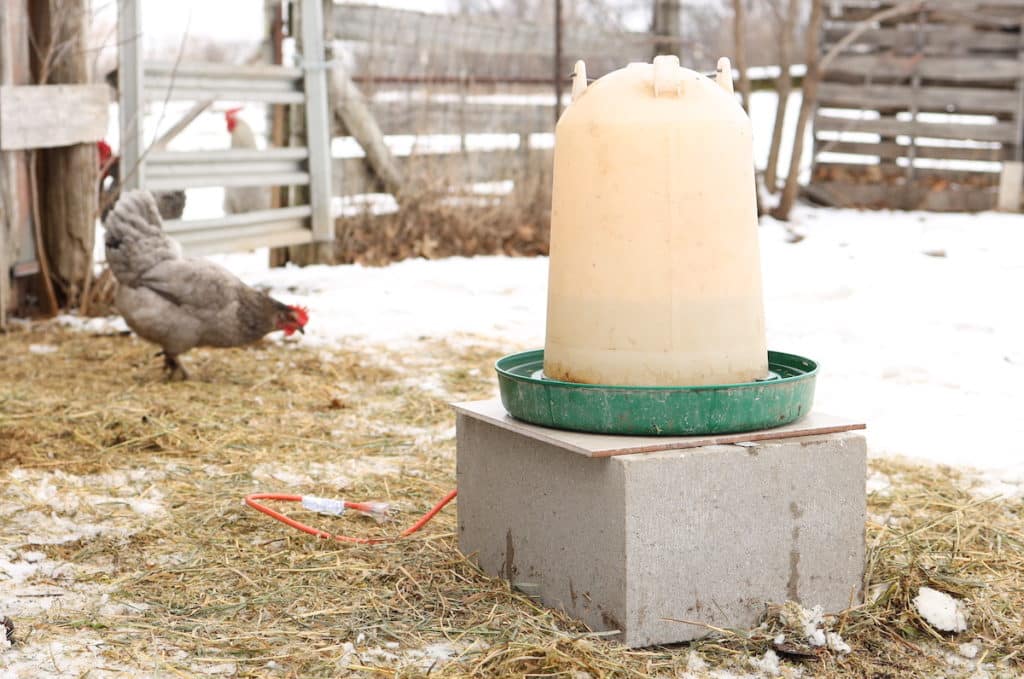
Easy DIY Heated Chicken Waterer
January 2, 2022
2. Heated Waterer – Think your standard chicken waterer setup but with a heating element built into the base. These work great, but just know when the heating element eventually goes out you’ll be replacing the whole thing.
3. Heated Bowl or Bucket – Farm stores commonly carry pet water bowls and buckets that can be plugged in and do a great job keeping water thawed. Many chicken keepers rely on these bowls and buckets for thawed water even on the coldest days.
Keep in mind that when winter temperatures get cold enough long enough, any water solution is susceptible to freezing up. During extended cold stretches, check your chicken’s water source often and either chip out any ice that forms or bring it inside temporarily to thaw.
4. Have Extra Food On Hand
Chickens, like most mammals, utilize digestion to maintain and control body heat. Making sure they have enough food, and the right type of food, on hand during the winter is essential.
With cold temperatures, complete layer feeds may not be enough. Here’s a few considerations:
1. Additional Feedings – We’ve found it helpful to not just give our hens their typical morning feed ration, but also feed them at night before they go up to roost and sleep. This extra fillup of carbs will help them keep their body temperatures stable during cold nights.
2. Scratch Grains – Many chicken keepers have a separate supply of scratch grains available to their flock during the winter so they can stock up on carbohydrates when needed. Chickens can quickly convert carbs to fat, energy, and warmth. Scratch grains are commonly whole grains or seeds like cracked corn, sunflower seeds, wheat, barley, oats, millet, and legumes.
3. Extra Protein – Snow and other wintery conditions can limit a chicken’s ability to forage and find the additional protein they are accustomed to. Plus, cold weather conditions like molting require additional protein needs for your flock. Our favorite source of protein is black soldier fly larvae from GrubTerra. They offer a high-quality product with the best bulk prices. Other protein options can be mealworms or sunflower seeds.

4. Hay – Giving your chickens hay, or cured pasture grasses and plants, can be a great replacement for fresh forage they lack in cold winter weather. Look for hay with tender grasses, not thick stems which they’ll avoid.
The bottom line is to plan to have extra food around during the winter and don’t skimp on the rations!
5. Prepare In Advance and Observe
As we’ve discovered, the hardest part of keeping any animals is having to troubleshoot and react once problems arise. This is especially true in the dead of winter! Preparing ahead of time and taking time to observe your chickens and react to problems quickly can save a lot of headaches down the road.
While the weather is still nice in the fall, go out and secure that plastic sheeting around your chicken run so you’re not caught off guard when that early winter storm rolls through.
Have electrical run to your coop well in advance so you’re not struggling with frozen fingers to unroll a stiff extension cord when their water starts freezing.
Stock up on some extra bags of feed or bedding so you don’t need to run out during that 3-day blizzard!
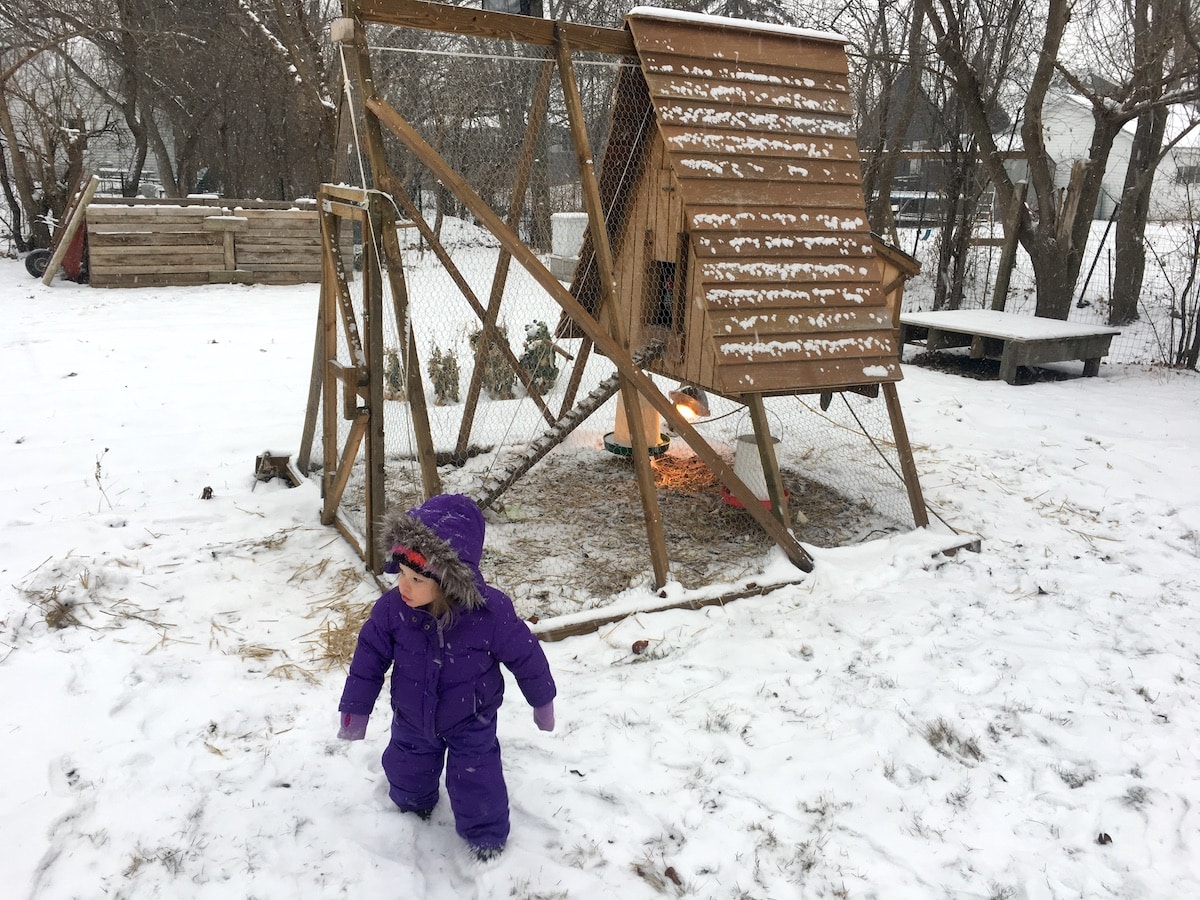
And then spend time out with your chickens and pay attention to their cues. Are there signs of frostbite setting in from damp conditions? Do I need a better windbreak to prevent cold drafts? Will they benefit from more food or extra bedding?
Keep watch and act quickly when you notice that something seems off.
Winter Chicken Care – Frequently Asked Questions
Will chickens still lay eggs in the winter?
Yes! Chickens will continue to lay eggs all year. However, you can generally expect fewer eggs in the winter.
The frequency that they lay is dependent on the amount of daylight they are exposed to. Chickens require at least 12 hours of light, and some breeds like closer to 14 or 16 hours. Egg laying will continue when daylight dips below these thresholds but at a reduced rate.
Some chicken keepers provide an artificial light inside the coop to simulate extra daylight and keep egg production up. Our preference is to keep the lights off and honor the chickens’ natural rhythms to slow down and rest during the winter months. We do, however, occasionally keep the lights on in our barn during the day in elongated cold stretches when the chickens are stuck indoors with little access to natural light.
You’ll also want to collect eggs more frequently during the winter. The colder it is the quicker eggs can freeze and crack open. To avoid this check for eggs every few hours, especially when it’s well below freezing.
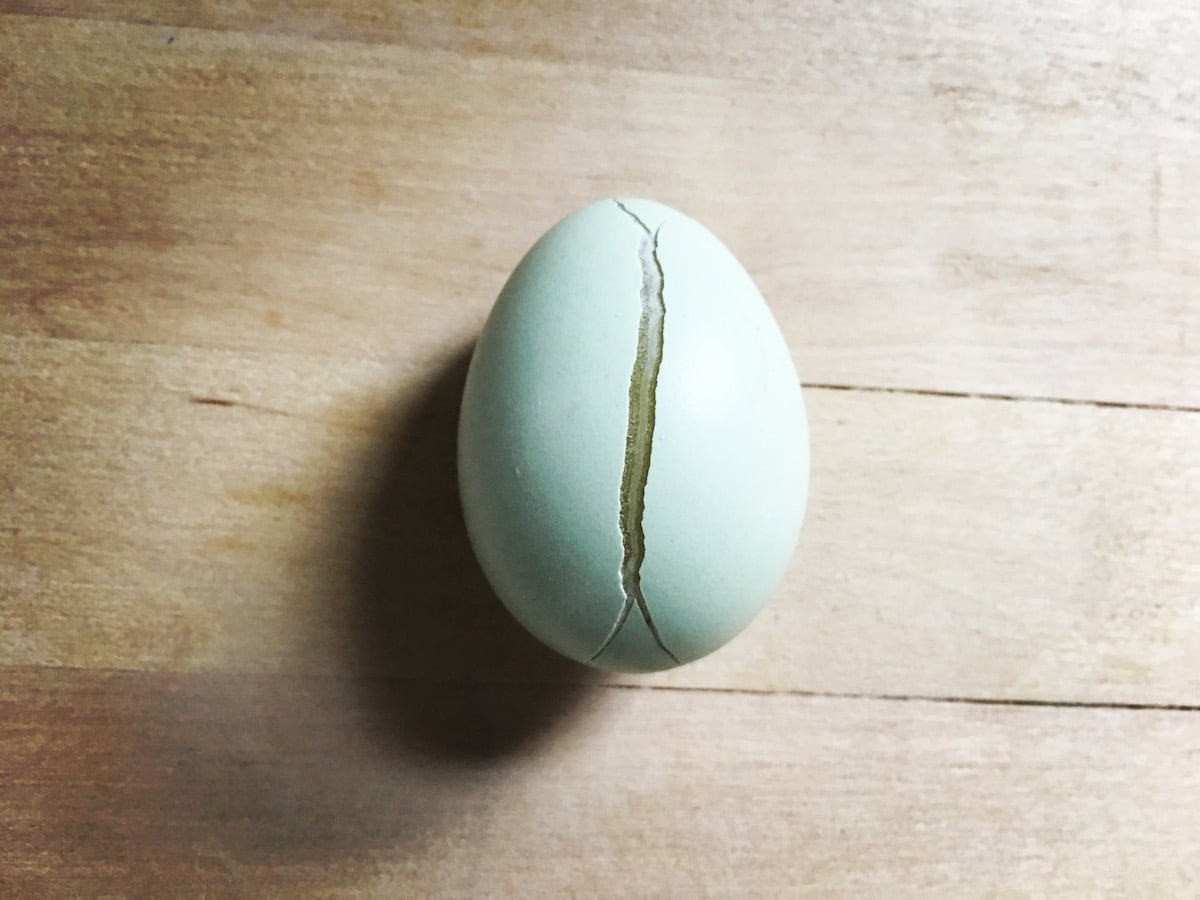
Should I be worried about frostbite for my chickens?
Frostbite is a concern and will most commonly target your chicken’s comb and wattle. These areas are vulnerable without feather cover. Keeping your coop dry and draft-free is your best prevention against frostbite, which can be caused by excess moisture combined with frosty wind and cold temperatures.
Another preventative measure chicken keepers have used is to spread petroleum jelly (or a natural alternative) on your chicken’s comb and wattle as an extra barrier against the cold.
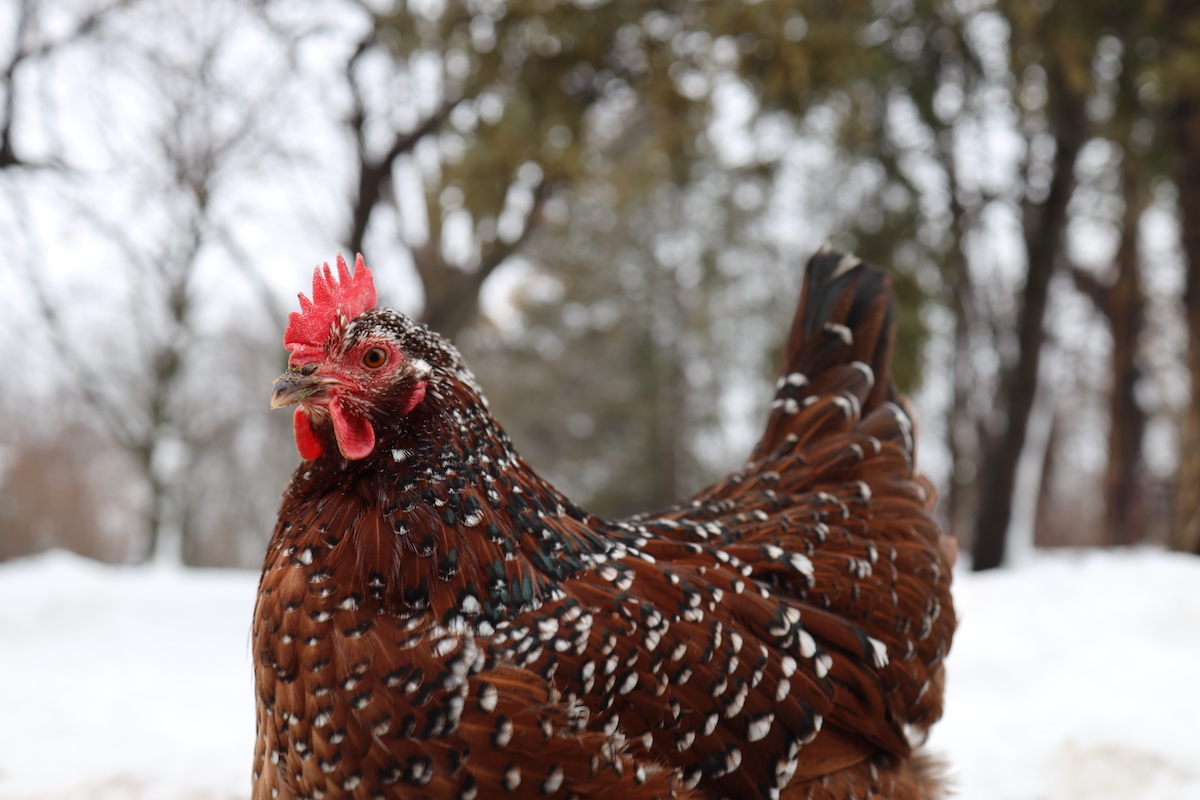
You’ll want to be observant and try to avoid frostbite as it is rather uncomfortable for your chickens. But if minor frostbite does occur, it’s not the end of the world. Our rooster had some on his comb this past winter, and a month into spring you couldn’t even tell it was there.
Are heat lamps necessary in my chicken coop?
Nope. Chickens are built for winter. And if you take all the steps above to give them a dry, draft-free coop with plenty of food and water they’ll be able to rely on their instincts to know what they need this time of year.
But it’s also not the end of the world to give them supplemental heat. We did have a heat lamp in our coops while living in the suburbs. We mainly pointed it at the waterer to help keep it from freezing since we didn’t yet have our concrete block heated waterer base.

One thing you’ll want to consider is that heat lamps are a potential fire hazard! So proceed at your own risk. We have a firefighter friend who told us of many instances of calls he got to coops and barns that stemmed from heat lamps. Other safer options exist like heated pads specifically designed for chickens.
Can my chickens free-range in the snow?
You bet! They’ll have just as much fun getting out and scratching around in the snow and cold as they do on a nice spring day. Thick snow cover can limit or prevent their ability to free range.
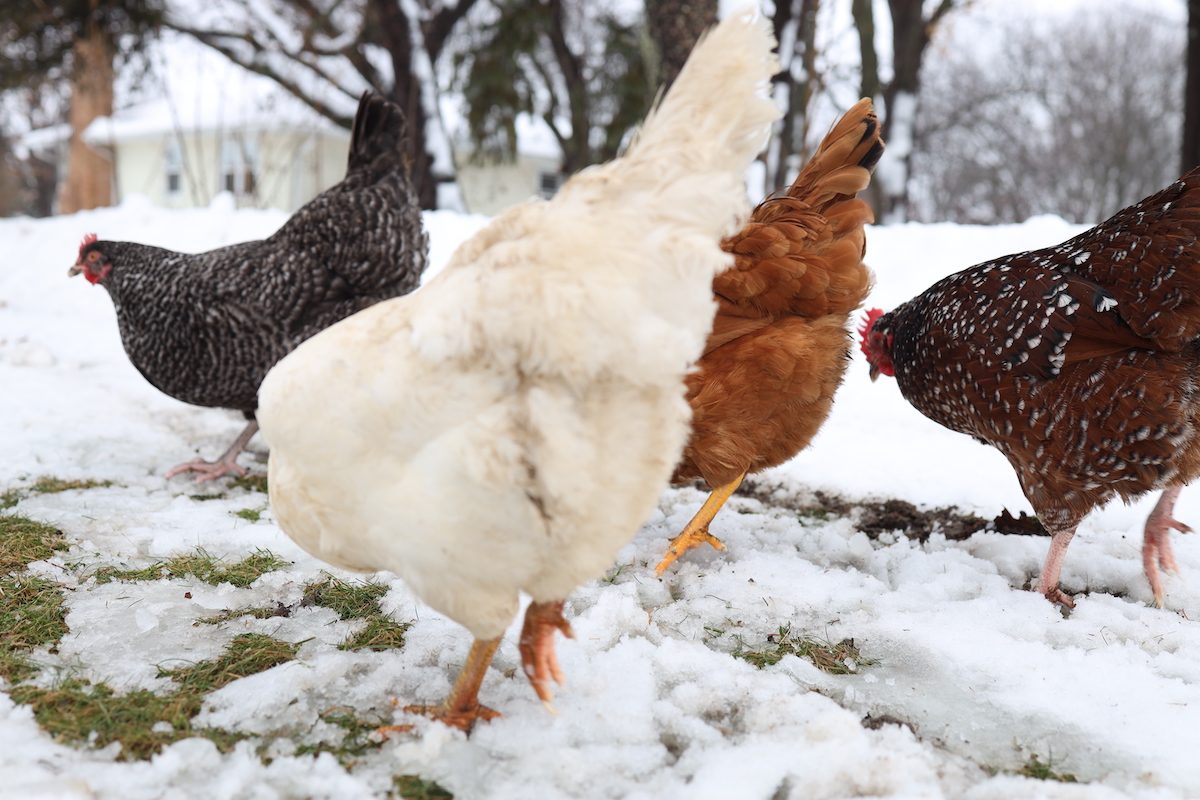
Consider shoveling out an area or path for your chickens to give them room to roam. Chickens can get stressed and irritated when cooped up. So giving your chickens the chance to roam, even throughout the winter, can help keep your flock happy and calm.
What are the most cold hardy breeds of chickens?
Most heritage chicken breeds are well suited for winter conditions. We have had some 10-15 different breeds over the years, which have all done well over the winter. While this list is not exhaustive, some of the main cold hardy winter chicken breeds are:
- Barred Rock
- Rhode Island Red
- Buff Orpington
- Ameraucana
- Easter Egger
- Salmon Faverolle
- Wyandotte
- Delaware
- Brahma
- Australorp
These breeds tend to have thick coats of feathers and higher body masses. Some even have smaller combs and wattles or feathers on other vulnerable areas like their feet. Even less cold hardy breeds can do fine during the winter if you keep conditions favorable. White Leghorns are known for their large combs and slender build, and we’ve had several that have weathered winters just fine in our current barn coop setup.
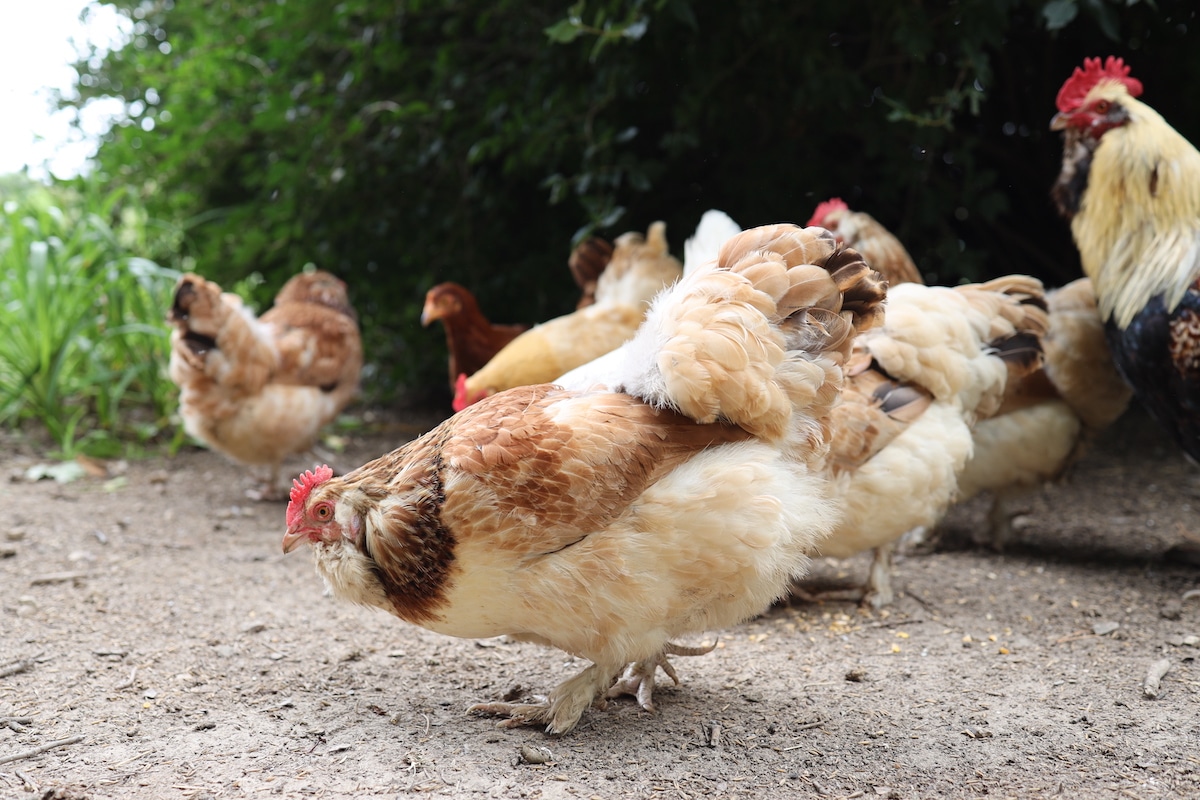
You Can Take Care of Chickens in the Winter!
Just remember: block the wind, keep it dry, figure out a good wintertime water and food situation, and be proactive.
With just these few basic measures, your chickens will take it from there and handle the winter like they were made for it. Because they are!
So don’t let wintertime hold you back from getting that backyard flock you’ve always wanted. You and your gals got this!
Want more helpful tips for your backyard flock?
Easy DIY Heated Chicken Waterer
Breaking Down The Cost of Chickens For Eggs
What Should Be Inside A Chicken Coop – Easy Guide!
Predator Proof Chicken Coop Essentials
How To Care For Baby Chicks
Simple Outdoor Chicken Brooder Ideas
Chicken Roost Designs | Two Simple DIY Ladder Perch Ideas
Custom A-Frame Chicken Tractor For (Almost) Free
Pin it for later!


